小学三年级英语下册知识点总结
- 格式:docx
- 大小:20.56 KB
- 文档页数:4
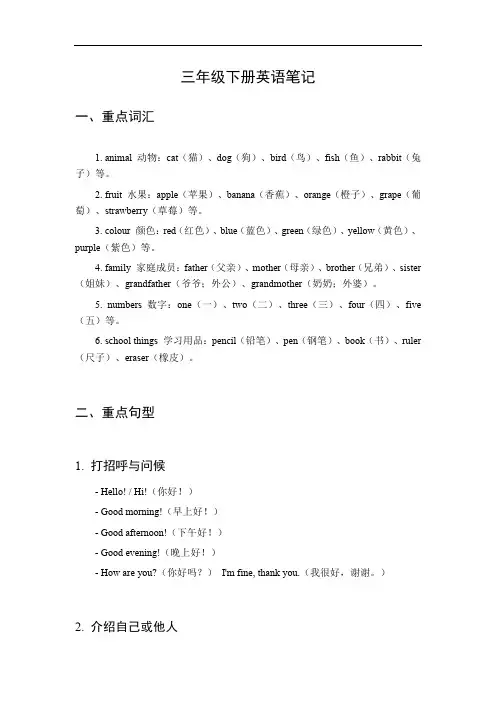
三年级下册英语笔记一、重点词汇1. animal 动物:cat(猫)、dog(狗)、bird(鸟)、fish(鱼)、rabbit(兔子)等。
2. fruit 水果:apple(苹果)、banana(香蕉)、orange(橙子)、grape(葡萄)、strawberry(草莓)等。
3. colour 颜色:red(红色)、blue(蓝色)、green(绿色)、yellow(黄色)、purple(紫色)等。
4. family 家庭成员:father(父亲)、mother(母亲)、brother(兄弟)、sister (姐妹)、grandfather(爷爷;外公)、grandmother(奶奶;外婆)。
5. numbers 数字:one(一)、two(二)、three(三)、four(四)、five (五)等。
6. school things 学习用品:pencil(铅笔)、pen(钢笔)、book(书)、ruler (尺子)、eraser(橡皮)。
二、重点句型1. 打招呼与问候- Hello! / Hi!(你好!)- Good morning!(早上好!)- Good afternoon!(下午好!)- Good evening!(晚上好!)- How are you?(你好吗?)I'm fine, thank you.(我很好,谢谢。
)2. 介绍自己或他人- I'm...(我是……)- This is...(这是……)3. 询问物品- What's this?(这是什么?)It's a...(这是一个……)- What are these?(这些是什么?)They are...(它们是……)4. 表达喜好- I like...(我喜欢……)- I don't like...(我不喜欢……)5. 询问颜色- What colour is it?(它是什么颜色?)It's...(它是……颜色。
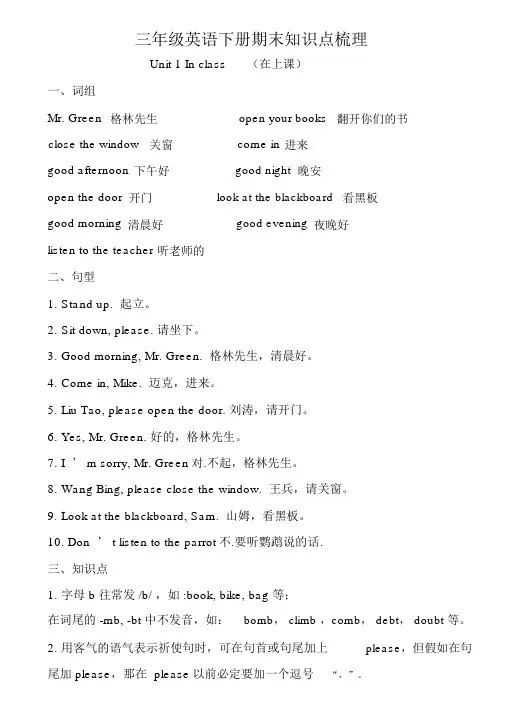
三年级英语下册期末知识点梳理Unit 1 In class(在上课)一、词组Mr. Green格林先生open your books翻开你们的书close the window关窗come in进来good afternoon下午好good night晚安open the door开门look at the blackboard看黑板good morning清晨好good evening夜晚好listen to the teacher听老师的二、句型1.Stand up. 起立。
2.Sit down, please. 请坐下。
3.Good morning, Mr. Green. 格林先生,清晨好。
e in, Mike. 迈克,进来。
5.Liu Tao, please open the door. 刘涛,请开门。
6.Yes, Mr. Green. 好的,格林先生。
7.I ’ m sorry, Mr. Green对.不起,格林先生。
8.Wang Bing, please close the window. 王兵,请关窗。
9.Look at the blackboard, Sam. 山姆,看黑板。
10. Don ’ t listen to the parrot不.要听鹦鹉说的话.三、知识点1. 字母 b 往常发 /b/ ,如 :book, bike, bag 等;在词尾的 -mb, -bt 中不发音,如:bomb, climb ,comb, debt, doubt 等。
2. 用客气的语气表示祈使句时,可在句首或句尾加上please,但假如在句尾加 please,那在 please以前必定要加一个逗号“,”。
:一.正确的序号填入括号中。
() 1. It ’ s too cold(冷). _______ the window, please.A. Don ’ t openB. OpenC. Don ’ t close() 2.Would you like to eat________?A. milkB. a pieC.an pie() 3. Don’t the parrot.A.listenB.look atC. look二.般配。
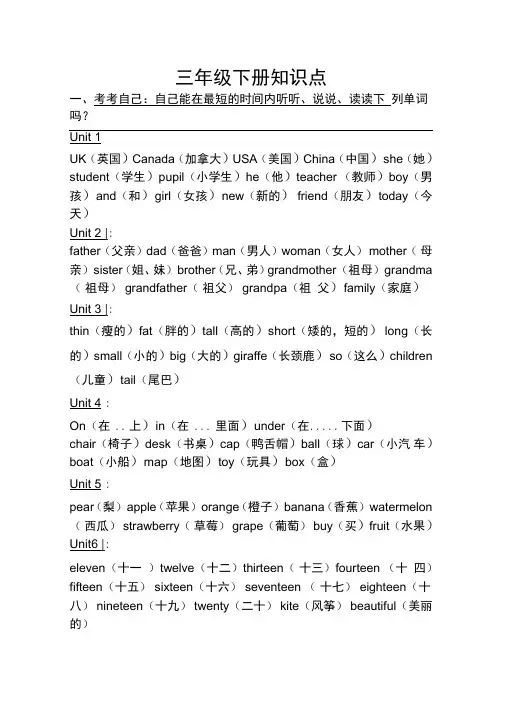
三年级下册知识点一、考考自己:自己能在最短的时间内听听、说说、读读下列单词吗?Unit 1UK(英国)Canada(加拿大)USA(美国)China(中国) she(她)student(学生)pupil(小学生)he(他)teacher (教师)boy(男孩)and(和)girl(女孩)new(新的) friend(朋友)today(今天)Unit 2 |:father(父亲)dad(爸爸)man(男人)woman(女人) mother(母亲) sister(姐、妹) brother(兄、弟)grandmother (祖母) grandma (祖母) grandfather(祖父) grandpa(祖父)family(家庭)Unit 3 |:thin(瘦的)fat(胖的)tall(高的)short(矮的,短的) long(长的)small(小的)big(大的)giraffe(长颈鹿) so(这么)children (儿童)tail(尾巴)Unit 4 :On(在 .. 上)in(在 ... 里面)under(在..... 下面)chair(椅子)desk(书桌)cap(鸭舌帽)ball(球)car(小汽车)boat(小船)map(地图)toy(玩具)box(盒)Unit 5 :pear(梨) apple(苹果) orange(橙子) banana(香蕉) watermelon (西瓜) strawberry(草莓) grape(葡萄) buy(买)fruit(水果)Unit6 |:eleven(十一)twelve(十二)thirteen(十三)fourteen (十四)fifteen(十五) sixteen(十六) seventeen (十七) eighteen(十八) nineteen(十九) twenty(二十) kite(风筝) beautiful(美丽的)二、牢记下面的对话,会让你的英语说得更好!更棒!1、欢迎别人时应该说- A: Welcome!(欢迎!)B: Welcome! (欢迎!)2、问别人介绍朋友的名字应该说-―― A:This is Amy. 这是艾米。
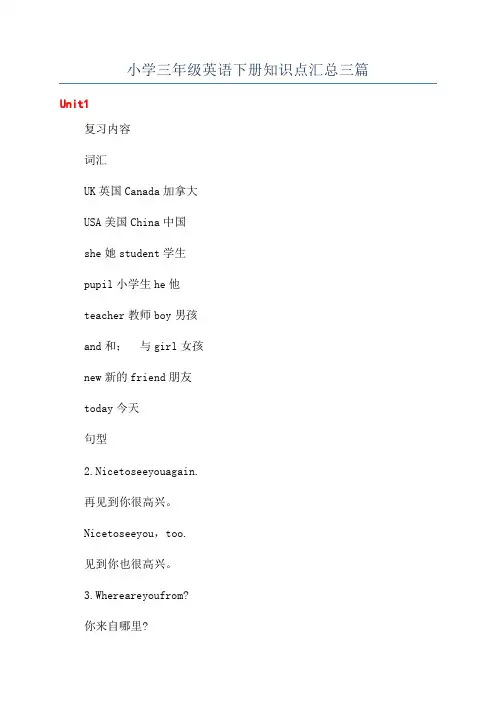
小学三年级英语下册知识点汇总三篇Unit1复习内容词汇UK英国Canada加拿大USA美国China中国she她student学生pupil小学生he他teacher教师boy男孩and和;与girl女孩new新的friend朋友today今天句型2.Nicetoseeyouagain.再见到你很高兴。
Nicetoseeyou,too.见到你也很高兴。
3.Whereareyoufrom?你来自哪里?I’mfromtheUK/USA.我来自英国/美国。
I’mfromChina/Canada.我来自中国/加拿大4.Wehavetwonewfriendstoday.今天我们有两位新朋友。
5.ThisisAmy.Sheisastudent.这是埃米,她是个学生。
6.ThisisMRJones.Heisateacher.这是琼斯先生,他是一位教师。
Unit2复习内容词汇father父亲;爸爸dad(口语)爸爸;爹爹man男人woman女人mother母亲;妈妈sister姐;妹brother兄;弟grandmother(外)祖母grandma(口语)(外)祖母grandfather(外)祖父grandpa(口语)(外)祖父family家;家庭句型1.Who’sthatman?Heismyfather.那个男人是谁?他是我爸爸。
2.Who’sthatwoman?Sheismymother.那个女人是谁?她是我妈妈。
3.Who’sthatboy?Heismybrother.那个男孩是谁?他是我哥哥。
4.Issheyourmother?Yes,sheis.她是你妈妈吗?是的,她是。
5.Isheyourfather?No,heisn’t.他是你爸爸吗?不,他不是。
6.Heismyteacher.他是我的老师。
7.Thismyfamily.这是我的家庭。
Unit3复习内容词汇thin瘦的fat胖的;肥的tall高的short短的;矮的long长的big大的small小的giraffe长颈鹿so这么;那么tail尾巴children(child的复数)儿童句型1.Lookatthatgiraffe.看那只长颈鹿。
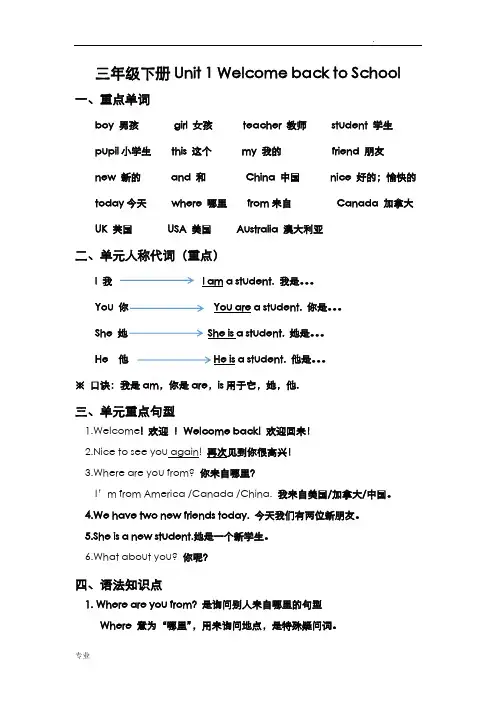
三年级下册Unit 1 Welcome back to School 一、重点单词boy 男孩girl 女孩teacher 教师student 学生pupil小学生this 这个my 我的friend 朋友new 新的and 和China 中国nice 好的;愉快的today今天where 哪里from来自Canada 加拿大UK 英国USA 美国Australia 澳大利亚二、单元人称代词(重点)I 我I am a student. 我是。
You 你You are a student. 你是。
She 她She is a student. 她是。
He 他He is a student. 他是。
※口诀:我是am,你是are,is用于它,她,他.三、单元重点句型1.Welcome! 欢迎!Welcome back! 欢迎回来!2.Nice to see you again! 再次见到你很高兴!3.Where are you from? 你来自哪里?I’m from America /Canada /China.我来自美国/加拿大/中国。
4.We have two new friends today. 今天我们有两位新朋友。
5.She is a new student.她是一个新学生。
6.What about you? 你呢?四、语法知识点1.Where are you from?是询问别人来自哪里的句型Where 意为“哪里”,用来询问地点,是特殊疑问词。
From “来自”的意思例如:Where is she from?她来自哪里?Where are you from?你来自哪里?2.I’m from.....是介绍自己来自哪里的句型。
I’m from +国家/城市/地名例如:I’m from Jiangxi.3.have 的用法(1)have可以表示“吃,喝”例如:Have some bread. 吃些面包吧。
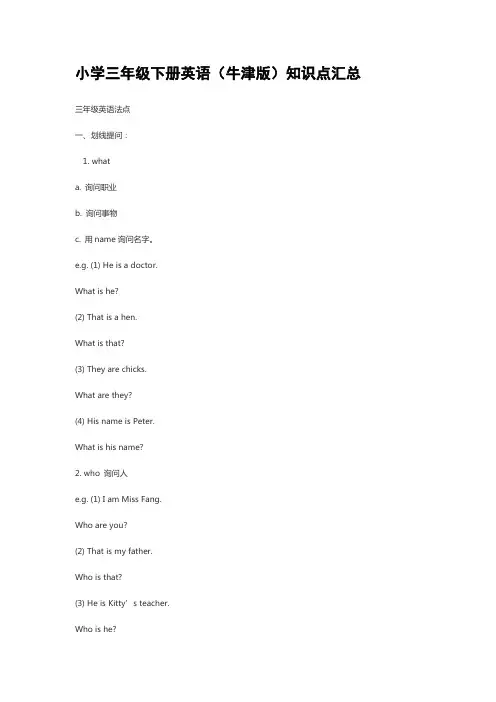
小学三年级下册英语(牛津版)知识点汇总三年级英语法点一、划线提问:1. whata. 询问职业b. 询问事物c. 用name询问名字。
e.g. (1) He is a doctor.What is he?(2) That is a hen.What is that?(3) They are chicks.What are they?(4) His name is Peter.What is his name?2. who 询问人e.g. (1) I am Miss Fang.Who are you?(2) That is my father.Who is that?(3) He is Kitty’s teacher.Who is he?3. what colour 询问颜色(1) This bag is blue.What colour is this bag? (2) They are yellow.What colour are they?4. howa. 询问身体状况b. 形容词(1) I’m fine. How are you?(2) He’s sad. How is he?5. how old 询问年龄(1) I’m nine.How old are you?(2) My sister is ten.How old is your sister?6. how many 问多少东西(1) Ten apples.How many apples?(2) One banana.How many bananas?7. how much 问多少钱(1) The apples are ten yuan.How much are the apples?(2) The pencil is one yuan.How much is the pencil?8. where 问地点The girls are in the park.Where are the girls?二、to be句型(一).否定句。
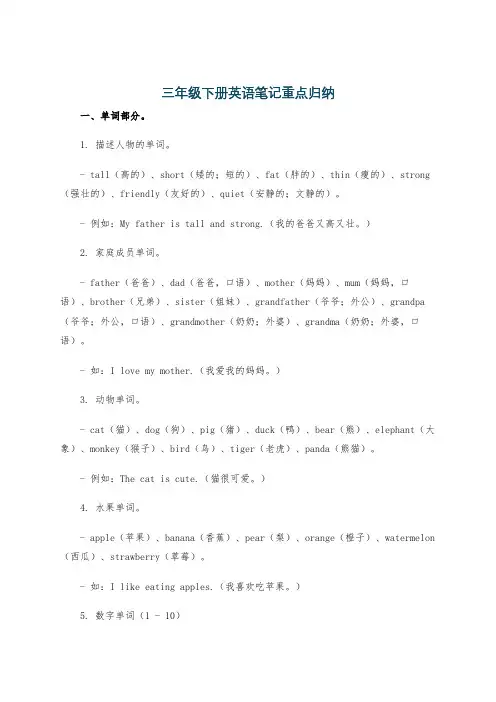
三年级下册英语笔记重点归纳一、单词部分。
1. 描述人物的单词。
- tall(高的)、short(矮的;短的)、fat(胖的)、thin(瘦的)、strong (强壮的)、friendly(友好的)、quiet(安静的;文静的)。
- 例如:My father is tall and strong.(我的爸爸又高又壮。
)2. 家庭成员单词。
- father(爸爸)、dad(爸爸,口语)、mother(妈妈)、mum(妈妈,口语)、brother(兄弟)、sister(姐妹)、grandfather(爷爷;外公)、grandpa (爷爷;外公,口语)、grandmother(奶奶;外婆)、grandma(奶奶;外婆,口语)。
- 如:I love my mother.(我爱我的妈妈。
)3. 动物单词。
- cat(猫)、dog(狗)、pig(猪)、duck(鸭)、bear(熊)、elephant(大象)、monkey(猴子)、bird(鸟)、tiger(老虎)、panda(熊猫)。
- 例如:The cat is cute.(猫很可爱。
)4. 水果单词。
- apple(苹果)、banana(香蕉)、pear(梨)、orange(橙子)、watermelon (西瓜)、strawberry(草莓)。
- 如:I like eating apples.(我喜欢吃苹果。
)5. 数字单词(1 - 10)- one(一)、two(二)、three(三)、four(四)、five(五)、six (六)、seven(七)、eight(八)、nine(九)、ten(十)。
- 例如:I have three pens.(我有三支钢笔。
)6. 方位介词。
- in(在……里面)、on(在……上面)、under(在……下面)、near(在……附近)。
- 例如:The book is on the desk.(书在桌子上。
)二、句型部分。

新人教PEP版三年级下册小学英语全册(单元知识点小结)Unit1Welcome back to school!一、核心词汇★★1.国家名词:UK 英国Canada 加拿大USA 美国China 中国2.与人相关的名词:student 学生pupil学生;(尤指)小学生teacher 教师boy 男孩 girl女孩friend 朋友3.常见人称代词:she她he 他4.其他:new新的today今天and和;与二、了解词汇★1.其他国家名词: Australia澳大利亚Japan 日本Russia俄罗斯France 法国Korea韩国2.其他人称代词:it它 I 我 we 我们they 他们you 你(你们)3.其他与人相关的名词:man男人woman女人4.短语:come from来自 a new teacher一名新老师play with和……玩儿三、核心句型★1.— Where are you from?你是哪里人?—I'm from the UK.我是英国人。
解读:be from 意为“来自……”;I'm是Iam 的缩写形式。
拓展;这是询问他人是哪里人的句型,其中be from可以替换为come from。
2.—Nice to see you again.再见到你们很高兴。
—Nice to see you,too.见到您也很高兴。
解读:“Nice to see you.”是日常见面常用的问候和寒暄用语。
3.Hi,I'm Amy.I'm from the UK.嗨,我是埃米。
我是英国人。
4.This is Amy.She's a new student.这是埃米。
她是一名新学生。
四、了解句型★1.Welcome!欢迎!2.We have two new friends today.今天我们有两个新朋友。
3.What about you?=How about you?=And you?你呢?解读:这三个句子可以通用,通常用于回答完别人的问题后,用同样的问题反问对方,希望对方回答相同的问题。
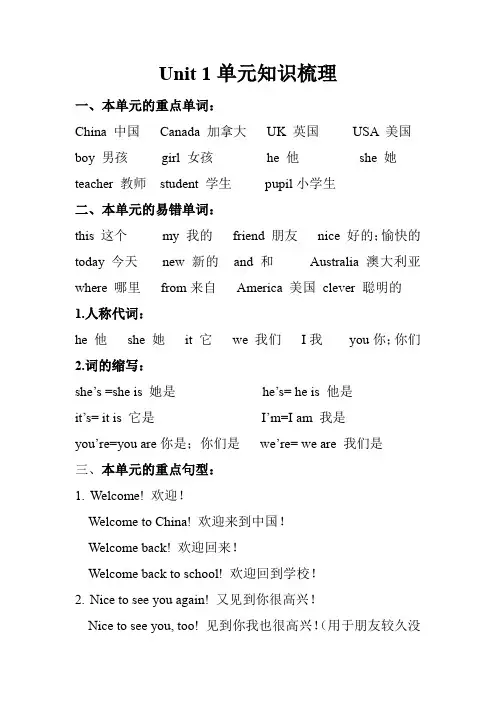
Unit 1单元知识梳理一、本单元的重点单词:China 中国Canada 加拿大UK 英国USA 美国boy 男孩girl 女孩he 他she 她teacher 教师student 学生pupil小学生二、本单元的易错单词:this 这个my 我的friend 朋友nice 好的;愉快的today 今天 new 新的and 和Australia 澳大利亚where 哪里from来自America 美国clever 聪明的1.人称代词:he 他she 她it 它we 我们I我you你;你们2.词的缩写:she’s =she is 她是he’s= he is 他是it’s= it is 它是I’m=I am 我是you’re=you are你是;你们是we’re= we are 我们是三、本单元的重点句型:1.Welcome! 欢迎!Welcome to China! 欢迎来到中国!Welcome back! 欢迎回来!Welcome back to school! 欢迎回到学校!2.Nice to see you again! 又见到你很高兴!Nice to see you, too! 见到你我也很高兴!(用于朋友较久没见面)3.Where are you from? 你来自哪里?(用于问别人来自哪儿)I’m from Canada /China. 我来自加拿大/中国。
(国家名称首字母要大写)4.We have two new friends today. 今天我们有两位新朋友。
I have a friend. She’s a girl. She’s a new student.我有一个朋友,她是一个女孩,她是一个新学生。
(介绍朋友的句子)5.What about you? = How about you? 你呢?(用于替代前面提到的问题)6.Can you read this? 你会读这个吗?Sure. 当然。
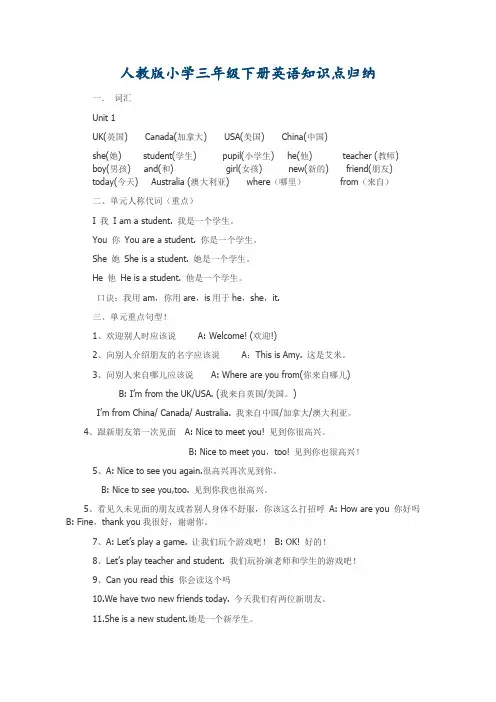
人教版小学三年级下册英语知识点归纳一.词汇Unit 1UK(英国) Canada(加拿大) USA(美国) China(中国)she(她) student(学生) pupil(小学生) he(他) teacher (教师)boy(男孩) and(和) girl(女孩) new(新的) friend(朋友)today(今天) Australia (澳大利亚) where(哪里)from(来自)二、单元人称代词(重点)I 我I am a student. 我是一个学生。
You 你You are a student. 你是一个学生。
She 她She is a student. 她是一个学生。
He 他He is a student. 他是一个学生。
口诀:我用am,你用are,is用于he,she,it.三、单元重点句型!1、欢迎别人时应该说A: Welcome! (欢迎!)2、向别人介绍朋友的名字应该说A:This is Amy. 这是艾米。
3、问别人来自哪儿应该说A: Where are you from(你来自哪儿)B: I’m from the UK/USA. (我来自英国/美国。
)I’m from China/ Canada/ Australia. 我来自中国/加拿大/澳大利亚。
4、跟新朋友第一次见面A: Nice to meet you! 见到你很高兴。
B: Nice to meet you,too! 见到你也很高兴!5、A: Nice to see you again.很高兴再次见到你。
B: Nice to see you,too. 见到你我也很高兴。
5、看见久未见面的朋友或者别人身体不舒服,你该这么打招呼A: How are you 你好吗B: Fine,thank you我很好,谢谢你。
7、A: Let’s play a game. 让我们玩个游戏吧!B: OK! 好的!8、Let’s play teacher and student. 我们玩扮演老师和学生的游戏吧!9、Can you read this 你会读这个吗10.We have two new friends today. 今天我们有两位新朋友。
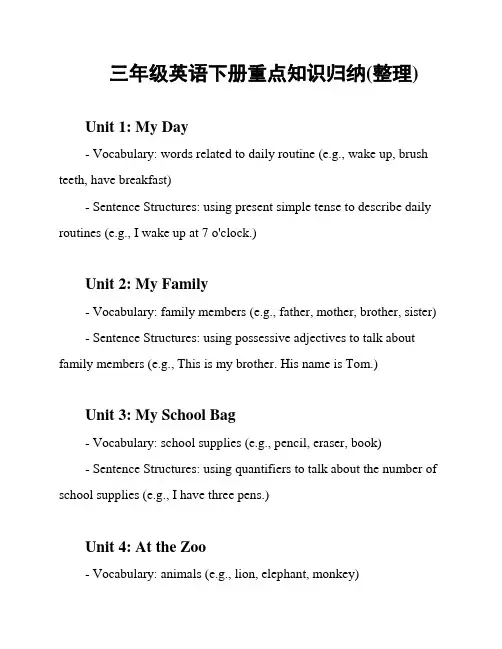
三年级英语下册重点知识归纳(整理)Unit 1: My Day- Vocabulary: words related to daily routine (e.g., wake up, brush teeth, have breakfast)- Sentence Structures: using present simple tense to describe daily routines (e.g., I wake up at 7 o'clock.)Unit 2: My Family- Vocabulary: family members (e.g., father, mother, brother, sister) - Sentence Structures: using possessive adjectives to talk about family members (e.g., This is my brother. His name is Tom.)Unit 3: My School Bag- Vocabulary: school supplies (e.g., pencil, eraser, book)- Sentence Structures: using quantifiers to talk about the number of school supplies (e.g., I have three pens.)Unit 4: At the Zoo- Vocabulary: animals (e.g., lion, elephant, monkey)- Sentence Structures: using the verb "can" to talk about the abilities of animals (e.g., A monkey can climb trees.)Unit 5: Our Body- Vocabulary: parts of the body (e.g., head, arm, leg)- Sentence Structures: using "have got" to describe body features (e.g., I have got short hair.)Unit 6: Festivals- Vocabulary: festivals (e.g., Christmas, New Year, Halloween)- Sentence Structures: using present simple tense to talk about festival traditions (e.g., We celebrate Christmas on December 25th.)Unit 7: Food and Drinks- Vocabulary: food and drinks (e.g., apple, hamburger, juice)- Sentence Structures: using "like" and "don't like" to express food preferences (e.g., I like pizza, but I don't like vegetables.)Unit 8: Weather- Vocabulary: weather conditions (e.g., sunny, rainy, windy)- Sentence Structures: using present simple tense to describe the weather (e.g., It is sunny today.)以上是三年级英语下册的重点知识归纳,希望能够对同学们的学习有所帮助。
PEP小学英语三年级下册Unit 1:boy男孩girl女孩teacher教师student学生this这个my我的friend朋友I’m=I am我是nice 好的、愉快的good morning早上好good afternoon下午好meet遇见、碰见too也、太goodbye再见Unit 2:father(dad)父亲、爸爸mother(mom)母亲、妈妈man男人woman女人Grandmother(grandma)祖母grandfather(grandpa)祖父sister姐妹brother兄弟let’s=let us让我们great太好了really真地、确切地and和、并且how 多么、怎么样Unit 3:eleven十一twelve十二thirteen十三fourteen十四fifteen十五sixteen十六seventeen十七eighteen十八nineteen十九twenty 二十how many 多少can 能够、可以look at 看、瞧Unit 4:peach桃pear梨orange橙子watermelon西瓜apple苹果banana香蕉strawberry草莓grape葡萄like喜欢some一些、某些thanks多谢Unit 5:bus公共汽车bike自行车taxi出租车jeep吉普车desk课桌chair椅子walkman随身听lamp台灯your你的、你们的zoo动物园Unit 6:small小的big大的long长的short短的、矮的tall高的giraffe长颈鹿deer鹿重点句子:Unit 1:1、Hi! /Hello! 你好!2、I’m Amy. 我叫埃米。
3、I’m from America /Canada /China. 我来自美国/加拿大/中国。
4、We have a new friend. 我们有一位新朋友。
5、Watch out! 小心!6、Where are you from? —I’m from China.你来自哪里?—我来自中国。
小学三年级英语下册知识点归纳总结1. 语法知识点
- 现在进行时:动词+ing,表示正在进行的动作
例:I am eating an apple.
- 一般现在时:表示经常性、惯性或客观事实的动作
例:___.
- 一般过去时:动词过去式,表示过去发生的动作
例:___.
- 一般将来时:will/shall + 动词原形,表示将来发生的动作例:We will go to the ___.
注意:人称代词的变化
2. 单词拼写
- 通过课本中的单词表,研究和掌握本学期所学的单词拼写。
3. 日常用语
- 学会日常生活中常用的简单英语句子,如问候、道别、询问等。
例:Hello, how are you? / Goodbye, see you later.
4. 对话与表达
- 研究掌握一些常见的对话和表达方式,如提出问题、回答问
题等。
例:
- Can you help me?
- Yes, I can help you.
- What's your favorite color?
- ___ blue.
5. 阅读理解
- 研究阅读理解的基本技巧,如理解文章大意、找出关键词等。
6. 句子构成
- 研究句子的基本构成和语序,如主语+谓语+宾语等。
例:I like ice cream.
7. 口语练
- 多进行口语练,提高口语表达能力。
可以通过模仿对话、角色扮演等方式进行练。
以上是小学三年级英语下册的知识点归纳总结,希望对你的学习有帮助!。
小学三年级英语下册复习教学知识点归纳总结第一篇:小学三年级英语下册复习教学知识点归纳总结小学三年级英语下册复习教学知识点归纳总结一、词汇(听、说、认读)1、apple banana orange peach pear watermelon grape strawberry2、big long small short tall3、brother father grandfather grandmother grandpa dad sister mom mother4、bus bike taxi jeep5、chair desk walkman lamp6、deer giraffe7、eight eleven fifteen fourteen thirteen twenty sixteen seventeen twelve nineteen8、friend girl teacher woman man student boy9、good morning good afterno on goodbyeg10、and can great how how many I’m Let’s like look at meet nice really some thanks this too your二、句型 Unit 11、We have a new friend today.2、This is my friend,Amy.Unit 21、Let’s watch TV.Great!Unit 31、I have a new kite.2、Let’s fly it!3、Oh!It's beautiful!4、The black one is a bird.5、Look at my new crayons!6、Open it and see!7、You have 16 crayons!Unit 41、What about pears?2、I like them very much..3、Let’s have some peaches andpears.4、Have some fruits.5、I don’t like bananas.Unit 51、Where is my car?2、On your desk?3、It’s under the chair.4、Excuse me, Amy.5、Here you are!Thank you.Unit 61、Look at the elephant!Wow!It’s so big!2、It has a long nose and a short tail.3、Oh,it’s so funny!/It’s so tall.4、You see.The giraffe is tall.The deer is short.5、Dad ,you’re tall.I’m short.6、You’re right.三、对话:1、Who’s that woman? She is my mother.Who’s that man? He is my father.Who’s that boy?/Look out!2、Where are you from? I’m from America.3、How many kites can you see?/How many crayons do you have?4、Do you like peaches? Yes ,I do./No, I don’t.5、Can I have an apple ,please? Certainly!6、Have some more ? No, thank you.7、Can I use your pencil? No problem.四、口语:1、Good morning,boys and gils!/Good afternoon!/Goodbye./Nice to meet you.2、Watch out!/Come in./I’m sorry.It’s OK./Come on./Wow,how funny./What a big fish!/It tastes good./Really?小学英语三年级下册复习要点分析及方法对于三年级的老师和学生来说,大约还有10课时的复习时间,面对时间紧、任务多、孩子小的这一情况,我们不得不充分利用好课堂上的有限时间。
三年级下册英语知识点(共10页) -本页仅作为预览文档封面,使用时请删除本页-三年级下册Lesson A How Are You?1. A: How are you你(身体)好吗?B: (I’m) fine/Very well/I’m OK/ alright(=all right) / just so-so/ not bad/I’m not feeling well. …(等等) Thank you./thanks. Howare you/ And you/How about you/ What about you 我很好,谢谢。
你呢?A: (I’m)fine/OK, too. 我也很好。
详讲:问身体健康状况句式 How + be +主语是英美国家较熟悉的人之间见面时常用的问候语,但并不是想深入交谈某人的健康状况,只是一种礼貌的问候方式,还可问/ How is he ( your mom…)---He’s / She’s + fine/ OK/ ②Thank you (= Thanks ). ③ And you/ How(What) about you / How are you,Mrs ,Miss 和MsMr ['mistə(r)] 先生Mrs ['misiz] 太太;夫人(用于已婚妇女姓名前)Miss [mis] 小姐,女士;(年轻未婚女子) Ms. [miz] 女士Mr. / Mrs. / Ms. / Miss + Family nameUncle / Aunt + Given nameSir / Madam 单独用Lesson B This Is My Son.1. Good morning/afternoon/evening.早上(上午)/下午/晚上好。
答语也相同。
在熟人或家人之间可省略good。
熟人之间的问候可加上称呼语,称呼语放在问候语之后且用逗号隔开。
如:Good morning , class!同学们,早上好!Good morning! 早上好!早上起床至中午十二点前用。
Unit1 On the farm1、单词:farm农场farmer农民pig猪cow 奶牛sheep绵羊a\an一个cat 猫dog狗chicken鸡duck鸭fish鱼bird 鸟animal动物horse 马rabbit兔子swim游泳fly飞sing唱歌dance跳舞run跑jump跳yes是no不是in在…里面on 在…上面under 在…下面box 盒子2、句型:What's this? It's a cow\pig. 这是什么?它是一头奶牛\猪。
Is this\it a duck? Yes,it is./No,it isn't.这(它)是一只鸭子吗?是的,它是。
/不,它不是。
Can you dance? Yes, I can./No,I can't.你会跳舞吗?是的,我会。
/不,我不会。
Can a horse run? Yes,it can./No,it can't.马会跑吗?是的,它会。
/不,它不会。
What animals can fly? Birds can fly. 什么动物会飞?鸟会飞。
Where is the cat? It’s on the box. 猫在哪儿?它在盒子上面。
What's in the box? An animal. 盒子里有什么?一只动物。
What's this ? It's a(an)_____ 这是什么?这是……Is it a ____? Yes,it is./No,it isn't .It's a____这是……吗?是的,它是。
/ 不,它不是,它是……Can you dance/fly/swim/sing? Yes, I can./No, I can't你会跳舞/飞/游泳/唱歌吗?是的,我会/ 不,我不会。
What animals can fly/run/swim? 什么动物会飞/跑/游泳?Where is the__? It's on/ in /under the __……在哪?它在…里面/上/下面。
英语三年级下册期末复习知识点归纳Module1- Module2一、重点单词1. 动物:monkey 猴子tiger 老虎 lion 狮子 an elephant 大象panda 熊猫 bear 熊(植物:tree 树)2. 形容词:big 大的 small 小的 fat 胖的 thin 瘦的 tall 高的 short 矮的 favourite 特别喜爱的3物品:toy玩具 car 小汽车 ship 轮船 doll洋娃娃 computer game电脑游戏 love喜欢 every 每个 letter字母 eraser橡皮擦二、重点句子1. What’s your favourite……? 你最喜欢的……是什么?My favourite ……is……我最喜欢的……是……It’s the ……它是……I love every……我每个……都喜欢。
2.colour, colour问颜色; letter, letter问字母; toy ,toy问玩具; song, song问歌曲。
3. What’s your/ his/ her favourite……? 你/他/她最喜欢的……是什么? My/ His/ Her favourite ……is……你/他/她最喜欢的……是……4. What’s your favourite song? 你最喜欢什么歌? It’s the ABC song. 是字母歌。
5. What’s your favourite colour? 你最喜欢什么颜色?6. What’s your favourite letter? 你最喜欢什么字母?7. Here you are? 给你。
Thank you. 谢谢。
8. (问单数) What’s this/that? 这/那是什么? It’s……它是……9.(问复数)What are they? 它们是什么?They’re……. 它们是……。
10. This monkey is small and thin. 这是一只又小又瘦的猴子。
11. That monkey is big and fat. 那是一只又大又胖的猴子。
12. That man is tall and thin. 那是一个又高又瘦的人。
13. What colour? 什么颜色?Module3-Module4一、重点单词1. 运动:football 足球 basketball 篮球 table tennis 乒乓球 riding my bike 骑自行车 morning exercises 做早操 swimming skipping游泳.2. 食物: meat 肉 rice 米饭 fish 鱼 milk 牛奶(画横线为不可数名词,单复数相同) noodles 面条(画横波浪线为可数名词,复数要加s/es)3. 水果: pear 梨 banana 香蕉 an apple 苹果an orange 橘子4. 家庭:grandpa 祖父grandma祖母 dad 爸爸= father 父亲mum 妈妈=mother 母亲 brother兄弟 sister 姐妹二、重点句子1.可数名词复数 llike +不可数名词动词ing(skip-skipping、swim-swimming、ride-riding)2. What do you like? 你喜欢什么? I like…... 我喜欢……。
3. I don’t like……. 我不喜欢……。
4. Do you like ……? 你喜欢……吗?肯定回答:Yes, I do. 是的,我喜欢。
否定回答:No, I don’t. 不,我不喜欢。
5. Does Lingling/she like ……? 玲玲/她喜欢吃……吗?肯定回答:Yes, she does. 是的,她喜欢。
否定回答:No, she doesn’t. 不,她不喜欢。
6. Does Dming/he like ……? 大明/他喜欢吃……吗?肯定回答:Yes, he does.是的,他喜欢。
否定回答:No, he doesn’t. 不,她他不喜欢。
7.Please pass me the ……请把……递给我。
8. Here you are. 给你。
Thank you.(=Thanks.) 谢谢。
9.主语是单数第三人称时,动词的变化:加es: do-does;go-goes ;watch-watches; 加s: like-likes; play-plays ; 特殊单词:have10.人称代词单数第三人称:she 她,he 他,it 它以及单独一人名字,如Ms Smart/ My brother/ My father /the cat/ the dog等,后面动词要加s/es例句:I go to school on Mondays. She goes to school on Mondays.11.be动词用法我用am,你用are, is连着他她它,单数is,复数are.Module5-Module6一、重点单词 (表示星期和科目的单词的首字母必须大写)1. 星期:Monday 星期一 Tuesday星期二 Saturday 星期六 Sunday星期天2.科目:Chinese 语文 Maths 数学 English 英语 Art 美术 Science 科学PE 体育Music 音乐 Class meeting 班会 Safety 安全3.做事:go 去 play 打(球) do 做sleep 睡觉 have(has)上(…..课)二、重点短语go to school 上学 go to work 上班 at home 在家 go home 回家go shopping 去购物 go swimming 去游泳 go fishing 去钓鱼 go skipping 去跳绳watch TV 看电视 play football 踢足球 play basketball打篮球have classes 上课 play table tennis 打乒乓球 in the morning在早上in the afternoon 在下午 with friends 和朋友一起a.m 上午 p.m下午 at school 在学校 on the phone 通电话三、重点句子1.Are you……? 你是……吗?Yes, I am.是的,我是。
/ No, I’m not. 不,我不是。
2.Is he/Tom ……? 他/汤姆是……? Yes, he is.是的,他是。
/ No, he isn’t. 不,他不是。
3. Is she /Amy at home? 她/艾米在家吗?Yes,she is.是的,她在家。
/ No,she isn’t. 不,她不在家。
4.He is only two years old.他只有两岁大(one year old 1岁大)5. She goes to school on Mondays. 她星期一去学校。
6. He doesn’t play football on Sundays. 他星期日不去踢足球。
7. Does Amy /she ……? Yes, she does./ No, she doesn’t.8. Does your mum go to work on Saturdays? 你妈妈星期六去上班吗?Yes, she does.是的,她去。
/ No, she doesn’t.不,她没去。
9. Does Tom/he ……? Yes, he does. / No, he doesn’t.10.What do you do+时间?你……做什么? I +活动+时间。
11. A: What do you do in the morning? 你早上做什么? B: I have classes. 我上课。
12. What do you have+时间?你……有什么课? I have +科目。
13A: What does Lingling have at school? 玲玲在学校上什么课? B1: In the morning, she has Chinese, Maths and English. 上午她有语文、数学和英语B2: In the afternoon, she has Art, PE and Music. 下午她有美术、体育和音乐。
Module7-Module8一、重点单词1. 季节:spring 春天 summer 夏天 autumn 秋天 winter 冬天2. 天气:warm 温暖的 hot 炎热的 cool 凉爽的 cold 寒冷的sunny 晴朗的 windy 有风的 snow 下雪 rain 下雨3. 方位词:in 在……里面 on 在…...under 在…下面 behind 在…后面4. 地点名词:bedroom 卧室 park 公园 lake 湖二、重点句子1. We fly kites in spring. 春天,我们放风筝。
2.It’s warm in spring . 春天是暖It’s hot in sunmmer . 夏天是热的。
It’s cool in autumn . 秋天是凉爽的。
It’s cold in winter . 冬天是寒冷。
2. A: What do you do in spring/ summer/ autumn / winter? 你在春天/夏天/ 秋天/ 冬天做什么?B1: I fly a kite in spring.春天,我放风筝. B2: I go swimming in summer. 夏天,我去游泳。
B3: I play football in autumn. 秋天,我去踢足球。
B4: I go skating in winter. 冬天,我去滑雪。
3. It’s warm today, but it’s raining. 今天暖和但下雨。
4. It’s snowing today. It’s very cold. 今天下雪,很冷。
5. A: Where’s ……? ……在哪?B1: It’s in the ….... 在…里面。
B2: It’s on the . 在……上面。
B3: It’s under the …... 在……下面。
B4: It’s behind the……. 在……后面。
6. We play in the snow in winter.我们冬天在雪地里玩。
7.In winter, he go skating in the snow. 冬天,他在雪地里滑冰。